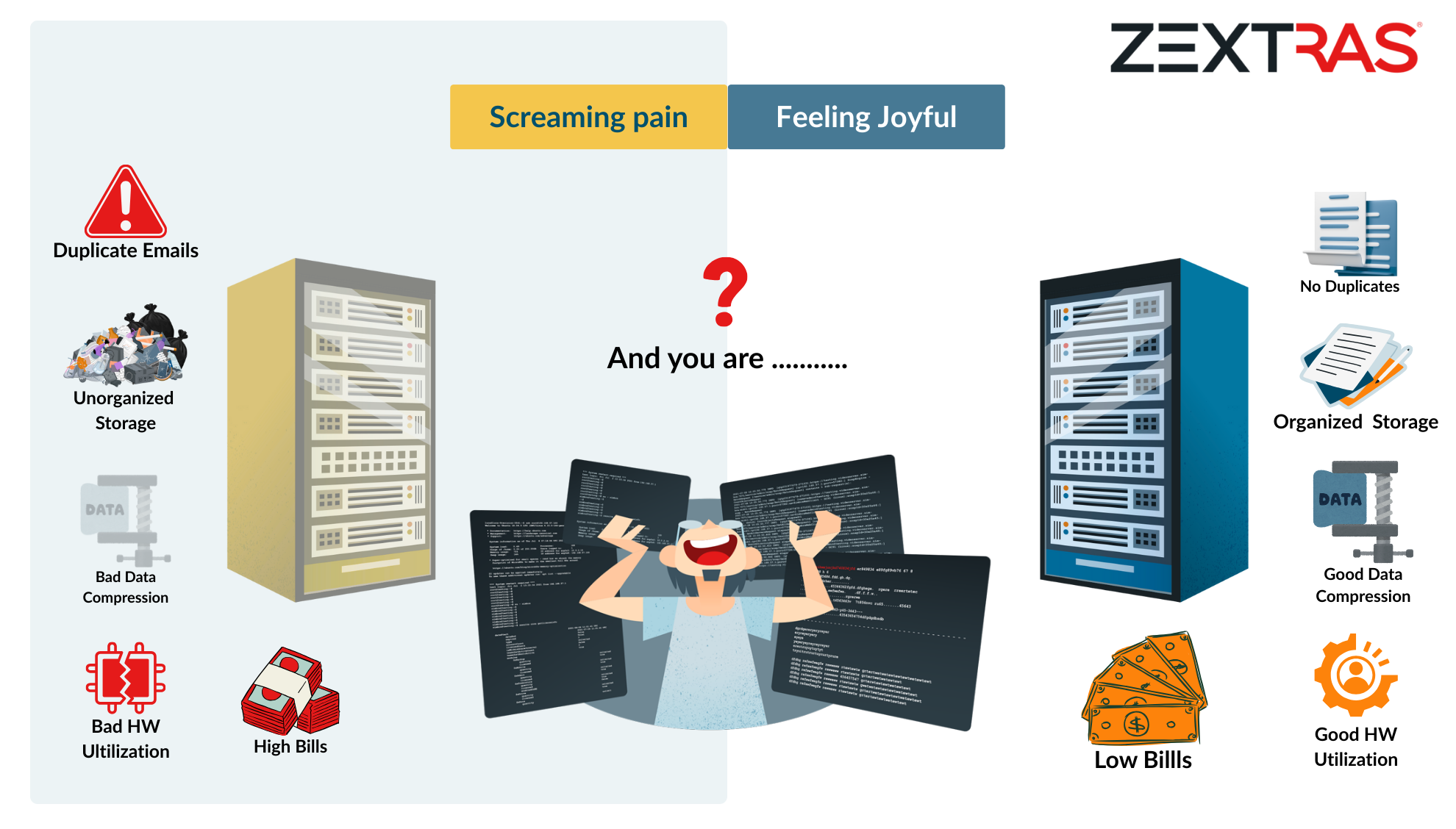Legacy email systems are notorious budget drains, consuming excessive storage, processing power, and IT administrative resources—driving up Opex and Capex while delivering poor ROI. Many organizations still struggle with outdated infrastructure that wastes valuable resources and limits growth potential. Resource saving in email collaboration refers to optimizing four critical areas: storage consumption, processing efficiency, bandwidth utilization, and administrative overhead. Modern collaboration systems are specifically designed with efficiency in mind, helping organizations reduce costs while improving performance and scalability.
Solutions like Zextras Carbonio exemplify this new generation of resource-efficient platforms, combining intelligent storage management with modular architecture to deliver measurable cost savings and operational improvements.

Why Resource Saving Matters in Email Collaboration
Most of the collaboration systems were never built for today’s massive volumes of communication and processes. Over time, they become bloated and inefficient:
- Storage bloat from duplicate attachments stored across multiple accounts.
- High CPU and disk I/O from inefficient indexing and search.
- Bandwidth inefficiency when large files move across the network without optimization.
- Admin overhead caused by siloed systems and lack of automation.
The industry has responded by shifting to more efficient, cloud-based platforms. In fact, over 60% of organizations now rely on cloud email collaboration solutions because they reduce Opex, delay Capex investments, and offer a stronger ROI compared to traditional on-premises systems.
Zextras Carbonio, by design, supports both cloud and on-premises deployment, giving organizations the flexibility to optimize resources according to their infrastructure needs. When combined with contemporary optimization strategies like compression and deduplication, email data volume and storage requirements can be reduced by 30 to 50%, postponing costly hardware upgrades and lowering energy consumption, which lowers the carbon footprint overall.
Efficient Data Management = Resource Saving
Effective data management serves as the foundation of resource optimization in email collaboration systems. Four key strategies drive the most significant improvements.
Strategic archiving and retention policies automatically remove outdated messages from active storage while maintaining compliance accessibility. This approach reduces primary storage loads and improves system performance.
Tiered storage implementation uses Hierarchical Storage Management (HSM) to move data between high-performance and cost-efficient storage based on access patterns. Frequently accessed data remains on fast storage, while archived data moves to cheaper alternatives.
Advanced indexing and search optimization enable rapid data retrieval while minimizing storage overhead through efficient metadata management and intelligent content organization.
Deduplication technologies eliminate redundant data copies, often achieving dramatic storage reductions without impacting user experience or system performance.
Research demonstrates substantial benefits from these efficient data management practices. The connection between efficient data management and lower Opex, delayed Capex, improved ROI, and sustainability has become increasingly clear as organizations prioritize environmental responsibility alongside operational optimization.
Real-World Implementation Scenarios and Measurable Benefits
Quantifiable Performance Metrics
- Time Savings and Productivity Gains: Enterprises consistently observe measurable efficiency improvements, with employees reclaiming tens of hours per week collectively across teams, equivalent to adding multiple full-time resources without increasing headcount.
- Email and Collaboration ROI: Streamlined communication and data management practices continue to provide significant returns on investment. Optimized storage, reduced duplication, and automated workflows reduce infrastructure and operational costs while enhancing overall productivity.
- Enterprise Collaboration Market Growth: The global enterprise collaboration market was valued at $54.67 billion in 2024 and is projected to reach $107.03 billion by 2030, growing at a CAGR of 12.1%. Cloud and hybrid deployments dominate, driven by their scalability, flexibility, and improved operational efficiency.
Cost Optimization Results
- Infrastructure Cost Reductions: Organizations adopting modern collaboration platforms report measurable reductions in storage and compute costs, along with lower administrative overhead. Streamlined workflows help achieve more with the same resources.
- Migration Efficiency Benefits: Predictable and structured migration approaches reduce operational complexity and provide cost transparency, contrasting favorably with traditional approaches that are often slower and more expensive.
- Operational Efficiency Improvements: Automation and process optimization enable enterprises to dramatically reduce time spent on repetitive tasks, improving throughput and employee productivity across teams.
Zextras Carbonio as a Resource-Efficient Example
While many vendors have embraced resource efficiency, Zextras Carbonio stands out as a modern, open-source collaboration platform built with optimization in mind.
Key features include:
- Hierarchical Storage Management (HSM): Automatically moves data between high-performance and cost-efficient tiers.
- Deduplication and compression: Cuts redundant storage and shrinks files without impacting performance.
- Hybrid storage integration: Flexible deployment across on-premises and cloud environments.
- Modular architecture: Organizations can deploy only the features they need, making better use of hardware.
These design choices enable Carbonio to lower total cost of ownership, reduce storage demands, and simplify IT administration. In short, Carbonio demonstrates how resource efficiency translates directly into operational and financial benefits.
The Future of Resource Efficiency in Collaboration
Looking ahead, resource optimization is becoming a central IT strategy. As businesses pursue digital transformation and sustainability, efficient collaboration platforms will be critical.
Trends shaping the future include:
- Green IT initiatives that cut the carbon footprint of email by reducing unnecessary storage.
- AI-powered data management, automating deduplication, tiering, and archiving.
- Real-time collaboration tools that reduce reliance on email-heavy workflows.
- Unified platforms that streamline communication and reduce redundant data.
Organizations that act now by adopting resource-efficient platforms are not just saving money—they are optimizing Opex, controlling Capex, and positioning themselves for higher ROI, while preparing for a more sustainable and scalable future.
Resource saving in email collaboration systems is no longer optional. By reducing storage bloat, optimizing bandwidth, and streamlining data management, businesses can achieve lower costs, better scalability, and improved sustainability.
Modern platforms make this possible, with Zextras Carbonio serving as a strong example of how intelligent design translates into efficiency. For a deeper dive into how Carbonio specifically reduces costs and enhances scalability, check out 👉 Optimizing Storage Efficiency: How Zextras Carbonio Reduces Costs and Enhances Scalability.
